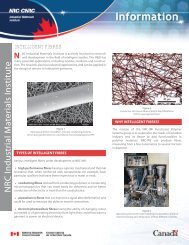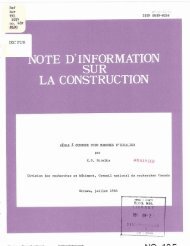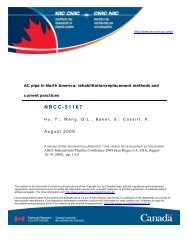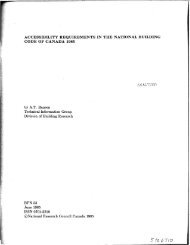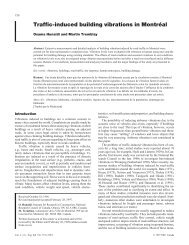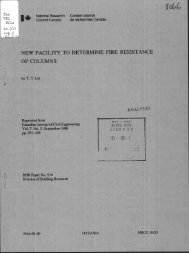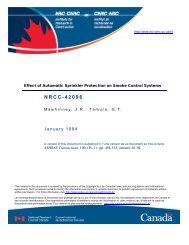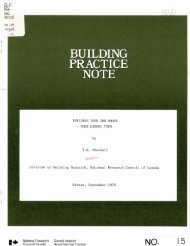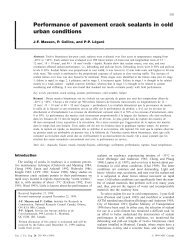Long-Term Thermal Resistance of Closed-Cell Foam Insulation ...
Long-Term Thermal Resistance of Closed-Cell Foam Insulation ...
Long-Term Thermal Resistance of Closed-Cell Foam Insulation ...
- No tags were found...
You also want an ePaper? Increase the reach of your titles
YUMPU automatically turns print PDFs into web optimized ePapers that Google loves.
http://irc.nrc-cnrc.gc.ca<strong>Long</strong>-term thermal resistance <strong>of</strong> closed-cell foaminsulation: research update from CanadaNRCC-50839Mukhopadhyaya, P.; Kumaran, M.K.2008-11-18A version <strong>of</strong> this document is published in / Une version de ce document se trouve dans:3 rd Global <strong>Insulation</strong> Conference and Exhibition, Oct. 16-17, 2008, Barcelona, Spain, pp. 1-12The material in this document is covered by the provisions <strong>of</strong> the Copyright Act, by Canadian laws, policies, regulations and internationalagreements. Such provisions serve to identify the information source and, in specific instances, to prohibit reproduction <strong>of</strong> materials withoutwritten permission. For more information visit http://laws.justice.gc.ca/en/showtdm/cs/C-42Les renseignements dans ce document sont protégés par la Loi sur le droit d'auteur, par les lois, les politiques et les règlements du Canada etdes accords internationaux. Ces dispositions permettent d'identifier la source de l'information et, dans certains cas, d'interdire la copie dedocuments sans permission écrite. Pour obtenir de plus amples renseignements : http://lois.justice.gc.ca/fr/showtdm/cs/C-42
3rd Global <strong>Insulation</strong> Conference and Exhibition, Barcelona, 16-17 October 2008developing world. Quite naturally, a higher thermal resistance (R-value) <strong>of</strong> insulatingmaterial is very much a desirable characteristic. Apart from instant energy savings it canalso help to render better long-term durability <strong>of</strong> materials and systems, more effectivemoisture management, enhanced indoor comfort and improved fire protection. However,the overall insulation benefit <strong>of</strong> these materials is dependent on their long-term thermalresistance (LTTR) or aging characteristics (Kumaran et al. 1989; Bomberg andKumaran, 1991; Kalinger and Drouin, 2001; Mukhopadhyaya et al. 2004). In order tounderstand the general behavior and LTTR <strong>of</strong> closed-cell foam insulation it is helpful toreview the basic physics <strong>of</strong> heat transfer as outlined below.Basic Physics <strong>of</strong> Heat TransferThere are three basic heat transfer mechanisms that control the insulating capacity <strong>of</strong>conventional thermal insulation materials and these mechanisms (Figure 1) are: (1)Conduction, (2) Convection, and (3) Radiation.Conduction occurs when constituent particles <strong>of</strong> the insulating material are in physicalcontact and energy is transferred through this contact.Convective heat transfer happens as a result <strong>of</strong> energy transfer by moving constituentparticles (i.e. gas or fluid) <strong>of</strong> the insulating material.Radiation takes place due to the emission <strong>of</strong> electromagnetic waves that transfer energyfrom the hot emitting object to a cold receiving surface and unlike conduction orconvection this mode <strong>of</strong> heat transfer can take place when there is no contact medium(i.e. vacuum) between two objects.(a) Conduction – HeatTransfer Through ParticleContact.(b) Convection – HeatTransfer in a FlowingMedium.(c) Radiation – Heat TransferDue to Emission <strong>of</strong>Electromagnetic Waves.Figure 1 - Basic physics <strong>of</strong> heat transfer
3rd Global <strong>Insulation</strong> Conference and Exhibition, Barcelona, 16-17 October 2008Performance <strong>of</strong> <strong>Thermal</strong> <strong>Insulation</strong>The most basic form <strong>of</strong> thermal insulation that had been used for the construction <strong>of</strong> thebuilt environment is the ‘air space’ between two layers <strong>of</strong> construction. With a betterunderstanding <strong>of</strong> heat transfer mechanisms and the advent <strong>of</strong> advanced manufacturingtechnology, the development <strong>of</strong> high performance insulation has been relatively slow butsteady in terms <strong>of</strong> the increased R-value <strong>of</strong> the thermal insulation.However, even now, enormous potential still exists to develop high performance thermalinsulating materials and systems for the built environment construction and thefundamentals <strong>of</strong> this development lie within the basics <strong>of</strong> heat transfer mechanismsthrough the air space. As shown in Figure 2 (Shirtliffe, 1972), heat flow through typicalair space is primarily due to convection and radiation. However, the introduction <strong>of</strong>reflective surface in the airspace can reduce the radiation component <strong>of</strong> the heat flow to aminimum level. Furthermore the addition <strong>of</strong> some fibrous materials that restricts theairflow inside the air space can transform the convective heat flow phenomenon almostnegligible.Hence, in any conventional insulation material, the three major components <strong>of</strong> heat floware: (1) air conduction, (2) radiation and (3) solid conduction (Figure 3). The solidconduction and radiation components are functionally related to the bulk density <strong>of</strong> theinsulation materials. However, for practical purposes the air conduction is treated as anindependent component and <strong>of</strong>fers a significant opportunity to develop high-performanceinsulation materials by effectively reducing this component and this is the basic principlethat leads to the development <strong>of</strong> closed-cell foam insulation.
3rd Global <strong>Insulation</strong> Conference and Exhibition, Barcelona, 16-17 October 2008What is <strong>Closed</strong>-<strong>Cell</strong> <strong>Foam</strong> <strong>Insulation</strong>?The basic structure <strong>of</strong> closed-cell foam insulation consists <strong>of</strong> two major components (1)polymer matrix, and (2) gas-filled closed cell (Figure 4). The captive gaseous blowingagent(s) fills up the closed-cells, surrounded by polymer matrix, during themanufacturing process <strong>of</strong> the foam. The thermal conductivity <strong>of</strong> blowing agent is usuallylower than air. In effect, the presence <strong>of</strong> blowing agents inside the closed-cell reduces theair conduction component <strong>of</strong> thermal conductivity significantly depending on the type <strong>of</strong>blowing agent used in the closed-cell foam insulation, as shown in Table 1 (Wu and Eury,2002). The thermal conductivity <strong>of</strong> most <strong>of</strong> the commonly used blowing agents is lowerthan half <strong>of</strong> the thermal conductivity <strong>of</strong> air.Table 1 – <strong>Thermal</strong> conductivity <strong>of</strong> blowing agentsBlowing Agent<strong>Thermal</strong> ConductivityBlowing Agent<strong>Thermal</strong> Conductivity[k gas @ 25 (°C) mW/m.K][k gas @ 25 (°C) mW/m.K]CFC-11 8.7 Hydrocarbon n-C 5 15HCFC-141b 9.7 HFC-134a 13.6HCFC-142b 11.5 HFC-245fa 12.2HCFC-22 11.0 HFC-365mfc 10.6Hydrocarbon c-C 5 12.0 Air 26In general closed-cell foam insulation has many desirable properties as insulation and aconstruction material such as:1. High r-value per unit thickness2. Fire resistance3. Moisture resistance and water repelling characteristics4. Dimensional stability5. Efficient filler for cavities, and6. <strong>Resistance</strong> to solvents commonly found in construction adhesives.However, it is also true that the thermal conductivity <strong>of</strong> the closed-cell foam insulation,due to the presence <strong>of</strong> captive blowing agents inside the closed-cell, increases over timeas air diffuses into and blowing agent(s) diffuses out <strong>of</strong> the closed-cells (Figure 5). Therate at which this diffusion (also called aging) occurs depends on a number <strong>of</strong> parameterssuch as properties <strong>of</strong> foam matrix, geometry and structure <strong>of</strong> the cells, exposure
3rd Global <strong>Insulation</strong> Conference and Exhibition, Barcelona, 16-17 October 2008conditions, density <strong>of</strong> material, manufacturing process, thickness <strong>of</strong> the insulation,chemical composition and permeability <strong>of</strong> the surfaces etc. This aging process <strong>of</strong> thefoam insulation is very rapid just after the manufacturing and slows down with the timeand almost reaches to an equilibrium state after a certain time. Hence, for the thermaldesign purposes, unlike traditional fibrous insulation materials, the long-term thermalresistance (LTTR) value is to be considered as the effective thermal resistance <strong>of</strong> theclosed-cell foam insulation. The researchers at the National Research Council (NRC)Canada, Institute for Research in Construction (IRC) have been researching on thevarious aspects <strong>of</strong> the LTTR characteristics <strong>of</strong> the closed-cell foam insulation for morethan 20 years now. A brief summary <strong>of</strong> these research activities and the technicalchallenges are presented in the following paragraphs.Solid Polymer Matrix<strong>Closed</strong> <strong>Cell</strong> (Blowing Agent)Figure 4 – Basic structure <strong>of</strong> closed-cell foam insulationPermeableBAAirFacersImpermeable<strong>Foam</strong><strong>Closed</strong>-cell Polyiso <strong>Foam</strong> <strong>Foam</strong>BoardFigure 5 – Aging <strong>of</strong> closed-cell foam insulation
3rd Global <strong>Insulation</strong> Conference and Exhibition, Barcelona, 16-17 October 2008Research on <strong>Closed</strong>-cell <strong>Foam</strong> <strong>Insulation</strong> at NRC-IRC: A Success StoryIn the late 1980s a very timely action by the NRC-IRC helped the plastic foam insulationindustry deal with a technical crisis stemming from environmental concerns.Up until that time, closed-cell foams, such as polyurethane foam, polyisocyanurate foamand phenolic foam used chlor<strong>of</strong>luorocarbons (CFCs) as a captive blowing agent to impartexcellent thermal resistance for insulation applications in buildings, exceeding thatprovided by traditional insulating materials such as glass and mineral fibre. Non-toxic,non-flammable and non-corrosive, CFCs were thought to be stable gases and wereconsidered ideal blowing agents. The foam industry thus maintained a strong share <strong>of</strong> themulti-billion dollar North American insulation market.This rosy financial picture faded abruptly with the discovery that CFCs escaping into theatmosphere pose a long-term danger to the environment. Free radicals resulting from theoccasional breakdown <strong>of</strong> the compounds eat away the ozone layer. When the extent <strong>of</strong>the problem became apparent, an international agreement known as the MontrealProtocol was signed by 24 nations in 1987 to restrict the use <strong>of</strong> CFCs in manufacturingtechnologies. In Canada this included a ban on the use <strong>of</strong> CFCs in foam insulation.With very little time to respond, the foam industry was in desperate need <strong>of</strong> a solution toenable it to hold onto its market advantage. That solution would be found in a researchproject between the Society <strong>of</strong> Plastic Industries (SPI) and NRC-IRC.The project began in 1988 and immediately it became evident that there was more to thiswork than simply replacing blowing agent A with blowing agent B. It was more a case <strong>of</strong>a radical change in technology because so many aspects <strong>of</strong> the foam cellular morphologyhad to be changed to obtain comparable thermal performance <strong>of</strong> foams using blowingagents with probably lower thermal effectiveness. The research challenge was to developaccelerated techniques to evaluate new materials and link them to the development <strong>of</strong>new foam products. An even greater challenge was to develop a methodology thatsubstantiated the long-term performance <strong>of</strong> viable products, using data from short-termlaboratory experiments and field-testing.To build on the incremental knowledge that was acquired over 20 years and to set thelinkage between the material and the test methodology development, the researchers firstdeveloped a generic and homogeneous foam product. Called Base 88, it represented the
3rd Global <strong>Insulation</strong> Conference and Exhibition, Barcelona, 16-17 October 2008industrial technology <strong>of</strong> sprayed polyurethane foams that existed in 1988. This genericproduct was manufactured by three industry participants in the project. Improved control<strong>of</strong> application variables generated in a sub-project permitted Base 88 to become highlyreproducible and suitable for drawing the "baseline" to compare any innovation. Hydrochloro-fluorocarbon(HCFC)-based blowing agents, such as HCFC-123, HCFC-141b,combinations <strong>of</strong> HCFCs with and without water, all alternatives to CFC-11, were thenintroduced. A new generation <strong>of</strong> alternative foam products resulted. A satellite projectbetween one <strong>of</strong> the partners and NRC-IRC focused on identifying desirable properties <strong>of</strong>new blowing agents. Principles and measurement methods from classicalthermodynamics, heat and mass transport, equations <strong>of</strong> state and even biology found theirway into the research activities. The research team delivered solutions to the Canadianfoam industry well within the time limit imposed by the Montreal Protocol. At that timethe industry was globally ahead <strong>of</strong> any other competition.Following on the heels <strong>of</strong> the successful project, the researchers at NRC-IRC, jointly withthe cellular plastic industry, developed a new Canadian National Standard calledCAN/ULC-S770 to "measure" the long-term performance <strong>of</strong> any innovative foamproduct. What is more, working with researchers from the Oak Ridge NationalLaboratory in the U.S., NRC-IRC researchers introduced various aspects <strong>of</strong> their researchfindings into the corresponding ASTM (American Society for Testing and Materials)International Standard (ASTM C1303) for polyurethane, polyisocyanurate, extrudedpolystyrene and sprayed polyurethane foam products. This has furthered North Americaninnovation and helped produce the modern generation <strong>of</strong> cellular plastic insulationmaterials. The innovation continues and interestingly enough innovations also bring newchallenges as outlined in the following paragraphs.Today’s ChallengesThough there is a standard test method now to determine the LTTR <strong>of</strong> closed-cell foaminsulation based on the scaling relationship (equation [1]) there are also many challengestoday arising primarily from variations in constituent materials, manufacturing processes,product thickness etc.tt12⎛ L= ⎜⎝ L12⎞⎟⎠2[1]
3rd Global <strong>Insulation</strong> Conference and Exhibition, Barcelona, 16-17 October 2008Where,t 1 & t 2 : Two different times, andL 1 & L 2 : Two different slice thickness.A significant amount <strong>of</strong> closed-cell foam insulation products are made with or withoutfacers in the form <strong>of</strong> a rigid board. Facers can be permeable or impermeable (Figure 5). Ithas been experimentally established that presence <strong>of</strong> permeable facer on both surfacesdoes not have any measurable effect on the LTTR value <strong>of</strong> closed-cell foam insulation.However, the introduction <strong>of</strong> impermeable facers on the surface is aimed at enhancing theLTTR properties <strong>of</strong> the closed-cell foam insulation.Research Significance and ObjectivesThe current research at the NRC-IRC focuses on the development <strong>of</strong> a comprehensivetest procedure that can be used to predict the LTTR <strong>of</strong> closed-cell foam insulationproducts with impermeable facers.More specifically, there are two major tasks involved in this project:1. Laboratory and field tests on specimens, and2. Analysis <strong>of</strong> the test observations/data with a numerical modeling tool (DIPAC-2D)(Bomberg and Kumaran, 1995).It is envisaged that by combining the output from the above two tasks, a methodologycould be developed that can be applied to estimate the LTTR characteristics <strong>of</strong> closedcellfoam insulation boards with impermeable facers.
3rd Global <strong>Insulation</strong> Conference and Exhibition, Barcelona, 16-17 October 2008Research Findings To DateIn general this research project established the fact that aging process <strong>of</strong> impermeablyfaced closed-cell foam insulation boards can be explained with the concept <strong>of</strong> combinedlateral and normal diffusion processes (Figure 6).BAAirNormal DiffusionSurfaceCoreSurface<strong>Foam</strong>LateraldiffusionFigure 6 – Diffusion processes in closed-cell foam insulationMore specifically the following observations could be made from analyses <strong>of</strong> the resultsobtained from the numerical model (DIPAC-2D) and examining experimental and fieldtest data.Firstly, while the laboratory measurements, field observations and numerical calculationsappear to agree well (Figure 7), there is an inconsistency with the lateral diffusioncoefficient. The lateral diffusion coefficient determined for different specimens (i.e. fullthickness and thin slices with facer) are significantly different. It is an important issuethat needs further research.Secondly, a considerable amount <strong>of</strong> aging occurred in thin slice specimens despite havinguntouched impermeable facers, as well as a glass plate at the bottom <strong>of</strong> the specimens andedges sealed completely with epoxy coating. This may be due to imperfections <strong>of</strong> the gasbarrier system.Further investigation on these issues would be imperative for the future progress towardsthe development <strong>of</strong> a methodology to predict the LTTR <strong>of</strong> closed-cell foam insulationboard with impermeable facer.
3rd Global <strong>Insulation</strong> Conference and Exhibition, Barcelona, 16-17 October 2008Figure 7 – Comparison <strong>of</strong> numerical, laboratory and field study resultsAcknowledgementsThe authors would like to acknowledge the financial supports provided by numerousstakeholders <strong>of</strong> the North American <strong>Thermal</strong> <strong>Insulation</strong> industry over a period <strong>of</strong> morethan 20 years to carryout the research on the long-term thermal performance <strong>of</strong> closedcellfoam insulation. The technical contributions made by Dr. Mark T. Bomberg in thisendeavour were <strong>of</strong> great importance.References1. ASTM C1303 (2007) “Standard test method for predicting long-term thermalresistance <strong>of</strong> closed-cell foam insulation”, ASTM International, West Conshohocken,PA, USA.2. Bomberg, M.T. and Kumaran M.K. (1991) “Evaluation <strong>of</strong> long-term thermalperformance <strong>of</strong> cellular plastics revisited”, ASTM Special Technical Publication,1116, Symposium on <strong>Insulation</strong> Materials: Testing and Applications (Gatlinburg, TN,USA, October 10, 1991), Philadelphia, PA: The American Society for Testing andMaterials, pp. 123-141. (ISBN: 0803114206), (NRCC-35950) (IRC-P-3197 ASTM-STP-1116).
3rd Global <strong>Insulation</strong> Conference and Exhibition, Barcelona, 16-17 October 20083. Bomberg, M. and Kumaran, M. K. (1995) “Use <strong>of</strong> the distributed parametercontinuum (DIPAC) model for estimating the long-term thermal performance <strong>of</strong>insulating foams”, <strong>Thermal</strong> Performance <strong>of</strong> the Exterior Envelopes <strong>of</strong> Buildings VI,Clearwater Beach, FL, pp. 15-24.4. CAN/ULC-S770 (2003) “Standard test method for determination <strong>of</strong> long-termthermal resistance <strong>of</strong> closed-cell thermal insulating foams”, Underwriters'Laboratories <strong>of</strong> Canada, 7 Underwriters Road, Toronto, Ontario M1R 3B4, Canada.5. Kalinger, P. and Drouin, M. (2001) “<strong>Closed</strong> cell foam insulation - Resolving the issue<strong>of</strong> thermal performance,” Commercial/Industrial Ro<strong>of</strong>ing Systems,October/November 2001, Trade Magazine Article, Johns Manville, USA(http://www.jm.com).6. Kumaran, M.K., Bomberg, M.T., Marchand, R.G., Ascough, M.R. and Creazzo J.A.(1989) “A method for evaluating the effect <strong>of</strong> blowing agent condensation on sprayedpolyurethane foams”, Journal <strong>of</strong> <strong>Thermal</strong> <strong>Insulation</strong>, 13 (October): 123-137. (Alsopublished in CFCs and the Polyurethane Industry: Vol 2: (A Compilation <strong>of</strong>Technical Publications, 1988-1989)), (NRCC-35473) (IRC-P-3106).7. Mukhopadhyaya, P., Kumaran K., Normandin, N., van Reenen, D. and Lackey, J.,(2008) “High performance vacuum insulation panel: Development <strong>of</strong> alternative corematerials”, ASCE Journal <strong>of</strong> Cold Regions Engineering, Vol. 22, No. 4 (in press).8. Mukhopadhyaya, P., Bomberg, M.T., Kumaran, M.K., Drouin, M., Lackey, J.C., vanReenen, D. and Normandin, N. (2004) “<strong>Long</strong>-term thermal resistance <strong>of</strong>polyisocyanurate foam insulation with gas barrier”, IX International Conference onPerformance <strong>of</strong> Exterior Envelopes <strong>of</strong> Whole Buildings, Clearwater Beach, Florida,December, 2004, pp. 1-10. (NRCC-46881). .9. Pelanne, C. M. (1978) “<strong>Thermal</strong> insulation: what it is and how it works”, Journal <strong>of</strong><strong>Thermal</strong> <strong>Insulation</strong>, Volume 1, April 1978, pp. 223-236.10. Shirtliffe C.J. (1972) “<strong>Thermal</strong> resistance <strong>of</strong> building insulation.” CBD-149, Institutefor Research in Construction, National Research Council, Ottawa, Canada.11. Wu, J. and Eury, S. (2002) “HCFC and HFC alternative blowing agents.” PU China,April 2002. © Arkema Inc.




